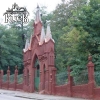Catholic part of Baikove Cemetery
The cemetery was established in 1833. It has got its name from the nearby Baikovo estate. The oldest part of the cemetery is located south of the present vul. Baikova. The biggest part is located north of the street and was established in the 1880s. It is partly surrounded by a wall. Besides the Orthodox graves there are also Catholic and Lutheran sections.
In Soviet times the Baikove cemetery became the main necropolis of the Kiev's intelligentsia, middle and upper classes. Many of the headstones became pieces of monumental art. Also after the Ukrainian independence the cemetery has remained the most prestigious burial ground in the city.
An Orthodox Church (Ascension of the Lord) in Byzantine style was built at the cemetery in 1884–1889. It was built on the proceeds from the sale of burial places. During the Soviet times it was preserved as a memorial hall for funeral ceremonies. Today it is again used as a church. In 1975 a new crematorium in modern style was built in the western part of the cemetery.
- Former Francois Hotel
- The Humanities Building of Schevchenko University
- Darnitsa cemetery
- House where Joachim Bartoshevich lived
- House where Boleslaw Lesmian lived
- House where Janusz Korczak lived
- House of public institutions
- House where Leonard Yankovski lived
- The Contracts House
- House with Chimeras
- Place where St. Joseph Church used to be
- House where Stanislava Vysotskaia lived
- The National Philharmonic of Ukraine
- St. Nicholas Roman Catholic Cathedral
- The building of charity association
- Former art school
- Red building of Taras Shevchenko National University
- House where Valerian Kulikovskii lived
- House where Vladimir Vysokovich lived
- National Opera
